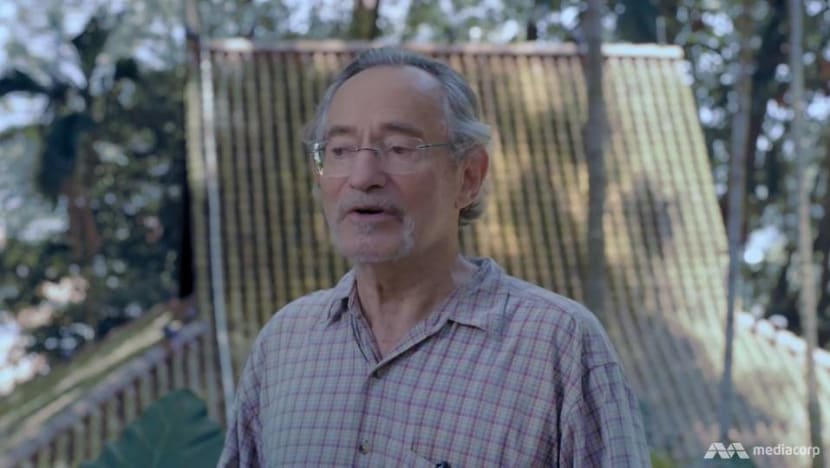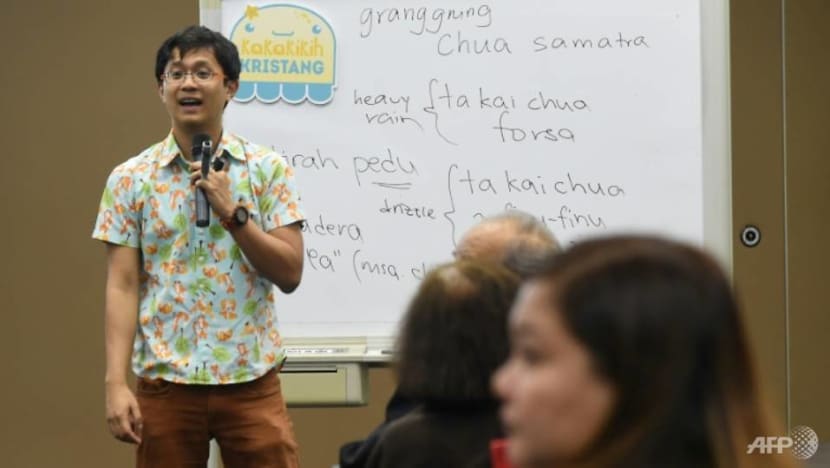In search of the real Singapore stories, beyond Raffles
As the bicentennial commemorations begin, questions are being asked on what Singaporeans know about their roots and how they look upon the past and their identity.

Models of the houses of the Orang Laut, indigenous sea people who navigated Singapore's waters for centuries.
SINGAPORE: It is an exploration of the dark side of Singapore’s colonial past: Fabric effigies of Stamford Raffles inspired by his statue in front of the Victoria Memorial Hall, but torn by the women who had made them.
The effigies were also tied with ropes and dyed. “You can see the scar marks of the ropes, like rope burns,” said artist Jimmy Ong, who described his artwork, Seamstresses’ Raffleses, as “something about dishonour rather than about heroism”.
“What I'm trying to say here is: Who gets to decide what our monuments are?”
The 53-year-old’s work represents a modern generation grappling with the legacy of colonialism. And 200 years after the British landed on a tropical island named Singapura, Raffles has been recast as both hero and monster.

School textbooks say Singapore was founded in 1819. For generations, this has been accepted as the nation’s official start date, while many were taught that Raffles transformed the mangrove swamps into a bustling port.
But this understanding of the past, with its emphasis on the colonial era, is changing, as the series Becoming Singapore finds out. (Watch it here.)
More of the complex canvas that is Singapore, shaped over hundreds of years by a blurring of ethnic boundaries, is being uncovered. And in a nation that prides itself on order, narratives are being questioned.
As long-gone figures are commemorated this year, what is being forgotten about Singapore’s other histories and lost to the march of time? Is there a blind side to our understanding of our diasporic past?
Or are Singaporeans often too forward-looking to concern themselves with bygone times?

FLOURISHING FOR OVER 700 YEARS
One man who has spent three decades hunting for clues to Singapore’s secrets has found them hidden on a hillside. Bukit Larangan (Forbidden Hill) – now known as Fort Canning – was once revered as the final resting place of Malay kings.
It is where Professor John N Miksic and his team started excavating in 1984, when “there’d never been an (archaeological) dig anywhere in Singapore”. They discovered 14th-century artefacts and a wealth of evidence of a flourishing society.
READ: Digging up the past: Searching for treasures to unlock more of Singapore's history
“There were craftsmen living here. They were manufacturing gold items and glass ornaments. So they were very highly skilled people using very sophisticated technology, which was quite rare anywhere in the world at this time,” said the 72-year-old.
“A 14th-century Chinese source said the people of Temasek lived on this hill, on terraces cut into it … implying that there were many people living here, not just the nobles. So it could’ve been already a large multi-ethnic group.”

Although a treasure trove of 14th-century gold was found at Fort Canning as early as 1928, it was not until the excavations began that a true picture of the past emerged.
Archaeologists have unearthed thousands of Indian and Javanese beads, Chinese coins and over half a million pieces of pottery – proof of a large, diverse and affluent community here.
The scale of these finds, however, are small compared with Singapore’s largest archaeological excavation, undertaken in 2015 in Empress Place. Three tonnes of materials like ceramics were recovered, which Mr Lim Chen Sian, who oversaw the dig, said was “mind-boggling”.
From the different types of artefacts, he believes the site might have been a commercial centre, “like a pasar or marketplace”.

“The bulk of the materials that we got, at least from the ceramics, were Chinese. And they were manufactured in the … 13th to 14th century,” said the 43-year-old.
It just shows that this huge amount of trade happened between ancient Singapore and the region.
The emergence of these objects – clues to a past that archaeologists are now piecing together – could make an impact, he thinks, because it comes at a time, since SG50, when Singaporeans “are facing a midlife crisis”.
“People are searching for their own past,” he said. “What exactly are we, right? So we’re looking for an identity, and I believe archaeology is one of the keys to that.”
To Prof Miksic, it matters that Singapore’s history goes beyond the colonial era because “the deeper that heritage, the stronger the country will be”. He said: “Modern Singaporeans aren’t alone. They do have ancestors to look back to for guidance.”

He added that people may be starting to understand that Singapore has a unique heritage “not brought in from … Melaka or elsewhere” and which is “stronger because it’s a hybrid society”.
“Singapore had it before Melaka did. So we can show that Singapore has been very successful in combining people from different origins – different talents – and making something very successful out of that for a very long time.”
LEGACY OF INTEGRATION
Singapore’s centuries-old legacy of integration as the driving force behind its success can be seen in Waterloo Street, which is famous for having places of worship housed side by side.
Visitors pay their respects, regardless of their religion. It is a tradition that has continued for over a century.

“These places of worship emerged in the late 19th century. And it seems to have taken place because of the diverse communities who took up residence here,” said Dr Imran Tajudeen from the National University of Singapore’s Department of Architecture.
“So you have, in the 1870s, the Hindu temple, Sri Krishnan Temple, which was contemporaneous with the emergence of the (Maghain Aboth) Synagogue, and then a decade later, the Guan Yin temple (Kwan Im Thong Hood Cho Temple).”
There is also the Church of Saints Peter and Paul, first completed in 1870.
“If you look at it from the perspective of a diverse society, then the city itself is an open textbook, telling us about older inter-ethnic links and how people lived next to each other,” added Dr Imran.

This multiculturalism at work, however, contrasts with what he thinks has been “an emphasis, for tourism purposes, on marketing large blocks of areas in Singapore as though they were mono-ethnic”, when that “isn't true”.
“There’s a danger that we’ll believe that artificial narrative, and then, by extrapolating from that, we’d assume that people lived in isolated blocs," he said.
“Rather than talk about these mono-racial blocs, we could talk about the fine-grain diversity. So, in that sense, using Waterloo Street is just a starting point because this isn’t the only such street in Singapore."
Life along that street represents the ties that bind. And despite the changes time brings, the ability to live together, regardless of differences, has been a constant in Singapore.

That is what Mr Francis Olsen, the father of Becoming Singapore presenter Eunice Olsen, remembers of the kampung days.
“Kampung life back then was integration, helping each other in need. We couldn’t get any help from our relatives because there were no relatives around. So who were the ones who were going to help you out? The neighbours,” he said.
His family were the only Eurasians in his kampung, but “nobody treated us differently – we were all poor”, recalled the 66-year-old. And he learnt to speak Teochew and Hokkien because of that integration.
We went to my neighbour’s place for tea, and they came over to our place sometimes for dinner. Segregation and prejudice and all that? There was none.
HISTORY’S ‘FORGOTTEN’ ACTORS
A lot of the old ways, however, even of our parents, are being forgotten. One person who is passionate about preserving the past is Mr Subbiah Lakshmanan, a fourth-generation Chettiar Singaporean.
The Chettiars are a South Indian caste. Skilled at investment and moneylending, they traded along the Singapore River from the 1820s. And Mr Subbiah, 54, thinks that such roots matter.

“After independence, we’ve been focusing so much on hardware because of survival,” he said. “But ultimately, what makes people overcome challenges is the software inside us.
For our future, if we don’t understand our past and don’t have strong software … (we) wouldn’t have the will to overcome.
He thinks it is important for families to have conversations about things that happened decades ago, especially as many people “are already in their 70s and 80s”.
“Official documents (and) newspapers only cover people whom I call ‘on the radar’, (and) official events. Nothing will be said about the common man, but they all had very rich and diverse lives,” he added.
“The only way you can capture that is through oral history … We can tell that story better, and that’ll make us richer. And that’ll help us face our future better.”
For Ms Olsen, however, knowing more about her Chinese roots in particular and talking about family history did not strike her as things to do until she began exploring Singapore’s past for this series.

She discovered that her mother’s side of the family sailed here from China in the 1880s, that for two generations, they painted horse carriages and then cars, and that their family home was in Dunlop Street in today’s Little India.
The 41-year-old could finally name her Chinese great-grandfather, Png Song Sai, the first in her family to be born in Singapore, in 1903. And for the first time, she could visit his final resting place, in Pu Ti Buddhist Temple.
It was a journey that made her wonder how much of Singaporeans’ personal histories and roots that “stretch far and wide” are unexplored, left to disappear without a trace.
“This is something that history books cannot write for us … We have to take it upon ourselves to write this story, by ourselves with our families,” said the former Nominated Member of Parliament.
“Our ancestors faced many adversities … and the march was long. And if we commemorate a stranger who landed here two centuries ago, we should surely look back and pay homage to the bravery of our own forgotten ancestors.”

REVISITING MALAY IDENTITY
One group of Singaporeans who have a connection to this island even before Raffles are the Orang Laut, the indigenous sea people who navigated these waters for hundreds of years.
With the dawning of the colonial era, their nomadic days were numbered. But their descendants live on after them. Mr Mohamed Nassir Ismail, for example, grew up along the Kallang River in a village populated by the Orang Laut.
It was called Kampong Kuchai, which his grandfather, as a community leader, helped to establish during the Second World War. It originally comprised 64 houses, which his grandfather knew how to build along the river.

“They worked like professional architects,” Mr Nassir said with a laugh. When asked what being a native Singaporean meant, the 63-year-old replied: “It means that we’re the origin of Singapore. We’re from the Singapore River.”
Despite his village’s thriving community, its time was short-lived. With the demolition of kampungs, residents moved into public flats. But his roots are still integral to his identity, and he keeps photos of his village.
“It’s so important to preserve our Orang Laut,” he said. “We belong to this small island. So (it’s) to tell others that we still exist.”

The place of Malays in Singapore’s history is something undergraduate Faris Joraimi also thinks is worth revisiting. He wants to change perceptions of local Malay culture.
“What's interesting is the fact that Singapore played an incredibly important role in what I’d like to think of as a renaissance of Malay literature, which happened in the early 20th century,” said the Yale-NUS College sophomore.
The heart of that renaissance was Kampong Glam, a port of call for Muslims from the region travelling to Mecca for the haj. “Naturally, every year there’d be a heavy influx of Malay-speaking, Malay-writing people,” noted Mr Faris.
Its history as a hub for Malay intellectualism, however, is one that not many may know.
The first commercial presses arrived in the 1860s. Over the decades, there was a surge in companies that produced Islamic and political works. Just along the short stretch of Bussorah Street, there were four or five publishers, including from Java.

One of Singapore’s best-known publishers was Al-Ahmadiah Press, established in 1920 by a group of aristocrats from the Riau islands. It printed religious literature, fiction and lifestyle magazines, in a place that now houses a boutique hotel, The Sultan Hotel.
“The fact that Malays had adopted the printing press and actively appropriated it for their own cultural and intellectual enterprise by the 20th century is incredibly significant,” said Mr Faris.
“Gentrification of course changes the way we think about urban spaces, so there's definitely a kind of laying over, I think, of this very important legacy."
READ: Heritage and gentrification: Is there a win-win for neighbourhoods?
He believes that knowing about this forgotten industry is crucial to young Malays’ identity.

“There’s already a vision of what the Malay Singaporean is. When you open a school textbook, you’ll probably see a picture of a fishing village, of a Malay farmer, and that's probably about it,” he explained.
“You don't learn so much about the modernity that the Malays in Singapore pioneered … And I think that's so important. And then you start to re-evaluate what your place is as a Malay person in Singapore in the 21st century.”
VANISHING CULTURAL MARKERS
Language and the arts have been crucial in defining the nation’s heritage. But can cultural remnants be saved from the brink of extinction?
That is the task one group of young people have taken on in reviving Kristang, a Portuguese and Malay creole that originated from 16th-century Melaka. It has no official written form and has survived through the spoken word.
READ: We're more than an ‘other’: Eurasians in search of their disappearing culture
READ: Kristang crusade: A new festival for a 500-year-old language
There were once thousands of Kristang speakers, but it is estimated that fewer than 100 remain in Singapore. Three years ago, the group Kodrah Kristang (Awaken, Kristang) was established, and it now teaches over 500 students.

The group’s leader Kevin Martens Wong started out as “somebody who just loved languages, who recognised the importance of maintaining linguistic and cultural diversity here”.
“Two thirds of our students are usually Eurasian. We do get a lot of younger people, especially non-Eurasians who are Singaporean. They feel invested in this part of Singapore’s shared heritage, and they want to help in some way,” he said.
To this 26-year-old, it dispels the stereotype that Singaporeans are insular.
“This is completely wrong because Kristang has served as a gateway … People come to class, learn about Kristang, and on top of that, they learn more about various aspects of Singapore’s history that they never thought about,” he explained.

That the group has non-Eurasians teaching in class also tells him that identity in Singapore is “always shifting” and a “dynamic idea”. He added: “We kind of put on and take off different identities in different circles.”
Mr Wong, who mastered Kristang only recently, came to teach his own Eurasian grandparents.
“(They) weren’t sold on it at first. I mean, who speaks Kristang any more, right? Then they came, they had a lot of fun and they’ve never skipped a class since, in the succeeding two years,” he said.
Grandfather Peter Martens described the class as “a great social mixer” and the learning as “another form of disruption”. “We’re always harping on skill sets and new skills, so why not Kristang?” said the retired teacher.

It is not only tongues nor pre-independence markers that have the potential to vanish. Architecture from the 1960s and 70s is also facing a fight for survival.
While there are over 7,000 conserved buildings in Singapore, only some 15 of them were built after independence.
And photographer Darren Soh, 43, who has a passion for documenting early Housing and Development Board blocks, is fearful something so common is vanishing before our eyes.
READ: ‘I’m afraid one day it’s going to go’: Saving Singapore’s old buildings one photograph at a time

He cited the flats that housed people who were moved after the 1961 Bukit Ho Swee fire.
“To just demolish them without either … documenting them or maybe trying to save one block out of a whole estate there will (leave) this big gap in our history,” he said.
While he is heartened that “a lot of the young feel very strongly for a lot of these old buildings”, he also thinks most Singaporeans “just go along with the ride”.
“Many of them have accepted that this is the way things are. And after a while we come to terms with it. But moving forward, maybe we need to start talking a little bit more about these things,” he added.
“What if it happened to your home and your childhood space that you feel attached to? Because you live in this place, you don’t have any say as to whether it gets demolished or not. How would you feel?”

To Ms Olsen, “what stays and what goes is often an impossible choice to make”. What she has come to realise is that “each one of us has a diverse, complicated and important story to tell”.
“For me, it’s clear that we must preserve this uniqueness whilst embracing all of our differences. Because what binds us together in this rich tapestry is the one place we call home,” she said.
Watch the series Becoming Singapore here.















